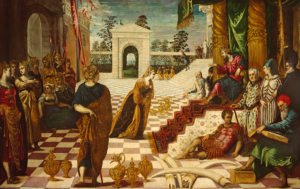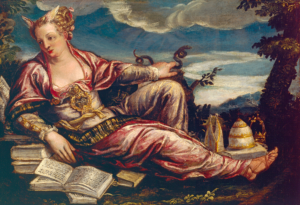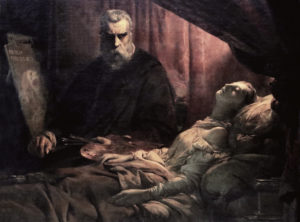Object of the Month: June 2021
The Visit of the Queen of Sheba to Solomon
Oil on Canvas
Jacopo Robusti, called Il Tintoretto
Venetian, 1519-1594
Allegory of Wisdom
Oil on Canvas
Marietta Robusti, called La Tintoretta
Venetian, c. 1554- c.1590
Jacopo Robusti, better known by his nickname, Il Tintoretto, was one of the most sought after and prolific painters in sixteenth-century Venice. He never lacked for commissions throughout his life and produced some of the city’s most famous canvases. The Visit of the Queen of Sheba to Solomon from the Museum & Gallery collection is one of his early works.
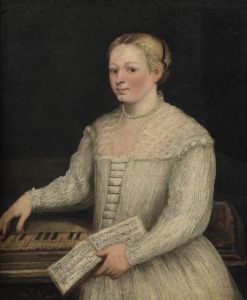 Jacopo’s success was in part due to his bustling family workshop which included two of his sons and Marietta his daughter, painter of M&G’s Allegory of Wisdom. In an article on Marietta, Louise Arizzoli points out that “Our reading of Renaissance masters as individual geniuses that started with Vasari’s Lives, sheds a negative light on those collaborators who remained in the shadow of the leading artist. These family workshops have however to be understood as teamwork, in which every member had specific responsibilities in order to ensure the quality of the commissions. Therefore, it is particularly difficult for us now to recognize individualities, as it was not the aim of the workshop to enhance individual style but to produce a certain style—that of Tintoretto” [Italics added]. This is one reason that apart from a small number of religious paintings and the Self-Portrait above (now in the Uffizi) few works are definitively assigned to Marietta. In addition, her talents were a close match to her father’s. This is especially evident in the figural details and similarities of brushwork and coloration in the two M&G works showcased.
Jacopo’s success was in part due to his bustling family workshop which included two of his sons and Marietta his daughter, painter of M&G’s Allegory of Wisdom. In an article on Marietta, Louise Arizzoli points out that “Our reading of Renaissance masters as individual geniuses that started with Vasari’s Lives, sheds a negative light on those collaborators who remained in the shadow of the leading artist. These family workshops have however to be understood as teamwork, in which every member had specific responsibilities in order to ensure the quality of the commissions. Therefore, it is particularly difficult for us now to recognize individualities, as it was not the aim of the workshop to enhance individual style but to produce a certain style—that of Tintoretto” [Italics added]. This is one reason that apart from a small number of religious paintings and the Self-Portrait above (now in the Uffizi) few works are definitively assigned to Marietta. In addition, her talents were a close match to her father’s. This is especially evident in the figural details and similarities of brushwork and coloration in the two M&G works showcased.
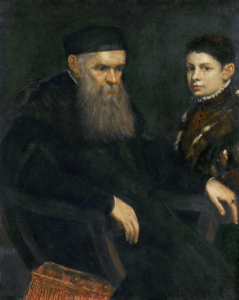 These mysteries of attribution are not only on-going but truly fascinating. For example, many scholars believe that several of Marietta’s works may simply have been incorporated into her father’s oeuvre. For example, Old Man and a Boy (Kunsthistorisches Museum) was considered one of Jacopo’s best portraits, but in 1920 Duncan Bull, a curator at the Rijksmuseum, reassigned the attribution to Marietta on the basis of the ‘M’ signature discovered on the work. (The ‘M’ is in the lower right of canvas beside the chair arm.) However, there are still scholars reluctant to accept this re-attribution.
These mysteries of attribution are not only on-going but truly fascinating. For example, many scholars believe that several of Marietta’s works may simply have been incorporated into her father’s oeuvre. For example, Old Man and a Boy (Kunsthistorisches Museum) was considered one of Jacopo’s best portraits, but in 1920 Duncan Bull, a curator at the Rijksmuseum, reassigned the attribution to Marietta on the basis of the ‘M’ signature discovered on the work. (The ‘M’ is in the lower right of canvas beside the chair arm.) However, there are still scholars reluctant to accept this re-attribution.
Two other important biographers detailing Tintoretto’s (and by extension Marietta’s) career are Raffaele Borghini (1537-1588) and Carlo Ridolfi (1594-1658). Both writers note that Marietta was not only exceptionally talented but also her father’s favorite. In his Le Maraviglie dell’Arte Ridolfi writes:
Marietta Tintoretto, then, lived in Venice, the daughter of the famous Tintoretto and the dearest delight of his soul. He trained her in design and color, whence later she painted such works that men were amazed by her lively talent. Being small of stature she dressed like a boy. Her father took her with him wherever he went and everyone thought she was a lad. She made a portrait of Jacopo Strada, the antiquarian of Emperor Maximilian, who presented it to his majesty as a rare work, whence the emperor, charmed by her valor, made enquiries about her of her father. Philip II, the King of Spain, and Archduke Ferdinand also asked him about her. However, Tintoretto was satisfied to see her married to Mario [Marco] Augusta, a jeweler, so that she might always be nearby, rather than be deprived of her, even though she might be favored by princes, as he loved her tenderly […] When she died her father wept bitterly, taking it as the loss of a part of his own inner being.
Marietta died four years before her father around 1590. The exact cause of her death is uncertain, but many believe she died in childbirth. Regardless, Ridolfi’s account of the close personal and professional relationship between the two would blur “into the myth of a young and talented woman painter who died too soon, leaving her father heart-broken.” We do know that Jacopo’s output began to fall off after his daughter’s death—whether because of grief or because of the loss of collaborative talent cannot be known. In any case, she would eventually become a muse for 19th century painters. Léon Cogniet’s Tintoretto Painting his Dead Daughter is perhaps the most famous among these Romantic paintings.
Donnalynn Hess, Director of Education
Published in 2021
